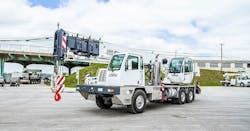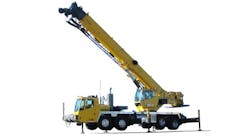The Latest in Truck Crane Technology
Truck cranes are largely rental items for many contractors, but that doesn’t mean manufacturers aren’t focusing on technology to increase efficiencies, safety, and utilization.
By their very nature, truck cranes must excel at two things: travel and robust heavy-lift capabilities. After that, the most significant value-add is likely the technology that helps managers and crane operators in day-to-day operation.
For contractors making one-off purchases of this big-ticket item or crane-rental operations seeking to replace or refleet, a number of considerations are at the forefront.
Truck crane ROI
“Return on investment, reliability, flexibility for transport, and product support are all factors that come into play for a crane owner when purchasing a truck crane,” says Andrew Soper, product manager for Link-Belt.
“Return on investment is measured by utilization, and since our cranes are leaders regarding reach, capacity, and transportability, it’s easier for owners to fill their job schedules and keep their cranes driving and lifting,” Soper says.
Product support and service is also critical.
“Product support is better than ever with features like telematics that not only improve utilization for crane owners with real-time data, but they also give owners the ability to improve the longevity of their crane purchase,” Soper says.
Mobility-wise, contractors and managers are seeking smooth highway performance to travel from job to job.
“We know that getting to the job is a big deal, and our truck cranes move down the road in cities and on the Interstate at a lower cost than all-terrain cranes,” Soper says. “Once on the job, truck cranes should have a good mix—great reach, great capacities, and the best transportability.
“Link-Belt truck cranes have a purpose-built chassis, which allows us to design the most efficient transport configurations that also have superior lifting capabilities,” Soper says. “By optimizing the transport of the crane, the number of overflow trucks is reduced. Additional features like auto engine idle help to keep fuel consumption low.”
How telematics benefit truck cranes
Technology available for truck cranes include not only telematics to keep track of fuel burn, location, and other machine performance parameters that aid in tracking and maintenance, but also features for ease of set-up, safety, and even lift planning.
“Our latest innovation to the truck crane lineup is our patented SmartFly,” Soper says. “SmartFly is easy to erect and stow because of simple yet unique design elements. Color-coded spring-loaded latches indicate which length fly is being erected or remaining stowed. A hydraulic cylinder and ramp releases the fly and returns it to its stowed position.
“Patented interlocking access gates keep the fly secure at all times and guide the operator through the proper steps for pinning and unpinning the fly,” Soper says.
“Boom head speed screws provide fast, complete alignment and engagement of main connecting pins, all with the operator at ground level. All of this adds up to a logical design that is robust, simple, and an efficient one-person operation,” according to Soper.
Liebherr’s mobile cranes feature the LICCON computer system for intelligent crane control. The LICCON2 crane control system can control crane movements from outside the cab.
After connecting with the crane via Bluetooth, the crane operator can use a small handheld remote control to extend the outriggers, raise them, then raise the boom to unhook the block. The handheld remote control then snaps into a larger handheld unit with joysticks on either side, which turns the housing for position, extends the boom, and allows full lifting capabilities.
Other functions include a working range limiting system designed to remove the strain from operators by automatically monitoring the working range limits such as bridges and roofs.
In addition, the job planner function is a program for planning, simulating, and documenting crane jobs, including searching for the most suitable crane and calculating maximum support forces and wind speeds.
Grove’s Crane Control System (CCS) is a standardized user interface that provides a common operating platform across multiple product lines (including the Grove, Manitowoc, and National brands). Each CCS crane features the same control layout to help operators, including a jog dial and a central display with standarized symbols and icons.
Also included is ECO mode software that detects operators’ working habits and controls rpm based on specified settings.
The company’s CraneSTAR telematics system allows managers to monitor an asset’s location and working conditions, plan maintenance, and verify working hours. Lift monitoring reports the exact amounts cranes are lifting, and a fuel consumption function measures fuel consumption per hour.
Reports and maintenance alerts can be sent to mobile devices.
The rental nature of the truck crane category isn’t going away any time soon, as they are expensive machines typically used for large jobs.
“We do not own any [truck cranes],” says Ernest Stephens, CEM, corporate equipment manager for Superior Construction, a Construction Equipment/Association of Equipment Management Professionals Fleet Masters Award winner and road and bridge contractor based in Portage, Indiana. “Neither do any construction companies I know of—that’s almost always a call to a rental house.”
Pre-pandemic numbers compiled by construction industry analyst Yengst & Associates showed sales of approximately 200 units or less annually, a figure likely reduced a touch further by Covid-19 and continued increased use of smaller types of cranes for traditional truck crane jobs. That being said, there is some optimism.
“The truck crane market is certainly trending better than last year with good indicators for growth in the second half of 2021,” Link-Belt’s Soper says.

